|
|
|
Sort Order |
|
|
|
Items / Page
|
|
|
|
|
|
|
| Srl | Item |
| 1 |
ID:
131763


|
|
|
|
|
| Publication |
2014.
|
| Summary/Abstract |
This article argues that the Aden Insurgency was a pivotal moment in the history of British counter-insurgency. We argue that it was in Aden where the newfound strength of human rights discourse, embodied in Amnesty International, and of anti-colonial sentiment, expressed by the UN General Assembly, forced the British government to pay attention to public perceptions of colonial brutality. Using archival sources, we foreground three episodes in the history of the insurgency to support our argument and to illustrate that the changes witnessed were not the result of 'learning' but of a fundamental shift in the international environment.
|
|
|
|
|
|
|
|
|
|
|
|
|
|
|
|
| 2 |
ID:
128389
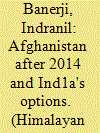

|
|
|
|
|
| Publication |
2011.
|
| Summary/Abstract |
Current speculation on the future of Afghanistan revolves around 2014, the year US forces are supposed to finally end their Afghan War mission. The key question is what will happen once the Americans depart? What sort of Afghanistan would emerge after that? Would the Taliban once again overrun that country and establish a ruthless Islamic emirate? Or would the pro-West regime in Kabul survive with the aid of the fledgling Afghan National Army and police? And where would all that leave India?
|
|
|
|
|
|
|
|
|
|
|
|
|
|
|
|
| 3 |
ID:
130888
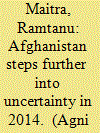

|
|
|
|
|
| Publication |
2014.
|
| Summary/Abstract |
2014 was long anticipated as the year of transition and ushering in of hope for Afghanistan. Three months of this important year are already behind us and, betraying earlier expectations, afghans continue to face stark uncertainties.
|
|
|
|
|
|
|
|
|
|
|
|
|
|
|
|
| 4 |
ID:
130865
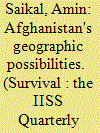

|
|
|
|
|
| Publication |
2014.
|
| Summary/Abstract |
Afghanistan's geostrategic potential is hampered by domestic weakness, regional tensions and major-power competition. Historically, Afghanistan's position at the junction between Asia and Europe has not only made it susceptible to outside invasions and influence, but also rendered it an important conduit for cross-continental interactions. The Greco-Bactrian (250-150 BCE), Kushan (30-375 AD) and Sassanid (224-651 AD) empires derived much of their wealth from the Silk Road, a series of interlinked trading networks criss-crossing the Eurasian land mass and centred around what is now known as Afghanistan. These routes served as the main arteries of east-west trade and transportation, until the disintegration of the Mongol Empire in 1368 AD effectively dismantled the network.
|
|
|
|
|
|
|
|
|
|
|
|
|
|
|
|
| 5 |
ID:
127712
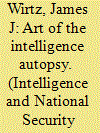

|
|
|
|
|
| Publication |
2014.
|
| Summary/Abstract |
Although intelligence postmortems are a common practice in the aftermath of intelligence failure, little is known about how they are conducted. This article explores the methodology employed by Robert Jervis in intelligence postmortems that followed the fall of the Shah of Iran in 1979 and the formulation of the 2002 Iraq national intelligence estimate that warned of the possibility that Iraq had restarted its nuclear program. The analysis reveals the challenges faced by scholars as they attempt to assess why analysts failed to offer accurate estimates and the way contemporary international relations theory can be applied to the realm of policy. The findings of the postmortems also shed light on areas where additional collaboration among scholars and analysts can advance the art of intelligence analysis.
|
|
|
|
|
|
|
|
|
|
|
|
|
|
|
|
| 6 |
ID:
134047
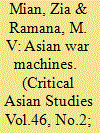

|
|
|
|
|
| Publication |
2014.
|
| Summary/Abstract |
The South Asian security landscape is increasingly dominated by a complex four-way dynamic between India, Pakistan, China, and the United States. The stresses and strains of the relationships between these states directly affect the prospects for peace and prosperity for almost half of humanity. This article describes some of the military contours of this landscape, with a focus on strategic postures, weapon acquisitions, and the role of nuclear weapons. It maps the India-Pakistan arms race over the past decade, the economic constraints on the two states, the role of China and the United States as weapons suppliers, and the risk and consequences for nuclear war. The authors then look at India's relationship with China, which is marked by both cooperation and competition, and the rise of China as a close military, political, and economic ally of Pakistan. While the United States has had long-standing cooperative relationships with both India and Pakistan, these relationships have been undergoing major shifts over the last two decades. U.S. concerns about China's increasing military and economic power have also intensified over this period as well. Of particular significance has been the effort to create a U.S.-India strategic partnership to balance and contain a rising China, which may become a central feature of the emerging global order. This article also offers a brief overview of what is publicly known about the nuclear arsenals of the four countries, ongoing production of weapons-usable fissile materials in Pakistan and India, as well as the race to build longer-range missiles.
|
|
|
|
|
|
|
|
|
|
|
|
|
|
|
|
| 7 |
ID:
130235
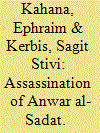

|
|
|
|
|
| Publication |
2014.
|
| Summary/Abstract |
Within the context of intelligence, the assassination of Egypt's President Muhammad Anwar al-Sadat on 6 October 1981 can be characterized as both a symbolic security failure and a failure to implement professional security principles by those responsible for guarding his life.
The circumstances creating the security "hole" were not confined to the short period preceding the assassination, but rather began long before, as part of an intense clash between two conflicting forces: extreme Islam and modern statehood.
In contrast to prevailing opinion, the apex of the struggle between these two forces is the main reason for the assassination, and not Sadat's peace with Israel. 1 The assassins of the al-Jihad group, springing unchecked from the substratum of fundamentalist Islam, carried out their work resolutely, exploiting the circumstances with almost incredible ease.
The sixth of October, observed in Egypt as a day of military triumph over the Israel Defense Forces (IDF) in the October 1973 War (the Yom Kippur War), is celebrated as an official holiday at the Grave of the Unknown Soldier on the outskirts of Cairo. On that date in 1981, on the reviewing stand stood President Sadat and his entourage: Vice President Hosni Mubarak; Defense Minister Mohammad Abu-Gazala; members of parliament; and members of the diplomatic corps, among them Israeli Ambassador Moshe Sassón.
Mirage fighter planes flew in celebratory formation above, and all in attendance were occupied with watching them and the huge parade passing before the reviewing stand, as columns of soldiers marched past the proud president.
When it was the artillery unit's turn to pass, a military truck stopped suddenly, from which four uniformed men sprang. Thinking this was part of the pageantry, no security personnel acted to prevent them from approaching the reviewing stand. One of the men quickly threw a grenade that did not explode, followed by more grenades. The assassins cocked their weapons and charged, firing at those on the reviewing stand.
The speed and suddenness with which the assassination was carried out resulted in pandemonium. People ran in all directions to take cover while Sadat stood, stiff and in shock, making him a clear target for sniper Hussein Abbas, 2 who shot him in the neck and chest. Sadat collapsed on the spot, yet this did not prevent another assassin, Abed al-Hamid, from emptying the rest of his rifle's magazine unhindered to confirm the kill. Sadat was flown by Gazelle helicopter to the Armed Forces Military Hospital at Ma'adi, but he arrived with no pulse, as his chest and arteries had been fatally penetrated.
The individual responsible for the assassination was Captain Khalid al-Islambouli. The fact that he and his partners managed to carry out this "inside job," despite explicit warnings having been received of threats on the president's life at the parade, testifies to a complete absence of common sense on the part of the Egyptian security sector.
The head of the Israeli security unit and lead investigator of the assassination, who was also responsible for Ambassador Sasson's rescue, was Avraham Rotem. According to Rotem, some members of Sadat's security detail were known to Rotem's unit personally due to previous reciprocal visits between Israeli and Egyptian personnel. 3 For this reason, the part played by Egyptian security personnel that day remains a mystery, due precisely to Israel's familiarity with them and the fact that they had acquired their security expertise from the best American instructional training. Sadat's assassination therefore raises a number of burning questions emanating from the fact that many in the upper Egyptian echelons knew that Sadat was in the opposition's crosshairs.
|
|
|
|
|
|
|
|
|
|
|
|
|
|
|
|
| 8 |
ID:
132215
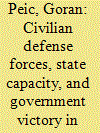

|
|
|
|
|
| Publication |
2014.
|
| Summary/Abstract |
Given the onset of a violent rebellion by an armed non-state group, how do states re-establish intra-state peace and hence fulfill their basic function as providers of internal security? In this article I argue that one way governments perform this core function is by recruiting non-combatants into local self-defense units called civilian defense forces (CDFs). By providing for local security, leveraging their superior local knowledge, and provoking insurgent reprisals against civilians, CDF units facilitate the influx of tactical intelligence as well as isolate insurgents from non-combatant populations physically as well as politically. Consistent with the argument, statistical analyses of two different cross-national data sets of insurgencies from 1944 to 2006 reveal that a state is 53 percent more likely to vanquish a guerrilla threat if the incumbent deploys CDFs. The analyses also cast doubt on a recent claim in the literature that incumbent force mechanization adversely affects the states' ability to counter insurgent threats. Given that CDF deployment is a more easily manipulable variable than most other elements of state power, CDFs appear to be an effective instrument of counterinsurgency deserving of further academic and policy attention.
|
|
|
|
|
|
|
|
|
|
|
|
|
|
|
|
| 9 |
ID:
131467
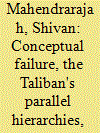

|
|
|
|
|
| Publication |
2014.
|
| Summary/Abstract |
ISAF exists to protect the Afghan constitutional model. This strategic objective will be defeated because the GIRoA model has a conceptual flaw that renders it incapable of delivering governance at the local level (Tier IV). This fatal flaw has enabled the Taliban, by developing parallel hierarchies, to displace GIRoA and establish itself in southern locales as the political authority. The Taliban are fighting a revolutionary war, a Maoist displacement strategy that uses guerrilla tactics to advance a political program. Petraeus and McChrystal failed to recognize the character of war, and believed the Taliban are pursuing an exhaustion strategy. They failed to devise a counter-RW strategy. The 'Surge' was doomed ab initio
|
|
|
|
|
|
|
|
|
|
|
|
|
|
|
|
| 10 |
ID:
130986
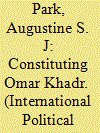

|
|
|
|
|
| Publication |
2014.
|
| Summary/Abstract |
Until 2012, Omar Khadr was both the only former child soldier and Western national left in Guantanamo Bay. Captured by US forces at the age of 15, this Canadian youth would spend more than 40% of his life in US custody during the War on Terror. This article advances two key arguments. First, as a child soldier, Khadr is simultaneously cast as an object of sympathy and suspicion. The construction of Khadr's childhood is animated by a cultural racism, which casts Khadr as both a victim of an extremist family and the evil outcome of a "jihadi" upbringing. Second, this article examines competing culturally racialized claims about citizenship, prompted by the failure of the Canadian government to seek Khadr's repatriation. While the central preoccupation of liberal citizenship discourse is the erosion of Canada's identity as a Western, liberal democracy, "racial-nationalist" discourse raises the alarm on the threat posed by "citizens of convenience" who must be cast out of the polity through practices of "pure exclusion."
|
|
|
|
|
|
|
|
|
|
|
|
|
|
|
|
| 11 |
ID:
131466
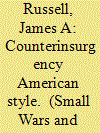

|
|
|
|
|
| Publication |
2014.
|
| Summary/Abstract |
This article examines the complex legacy of David Petraeus who was a key figure in the emergence of the US military shift towards counterinsurgency doctrine in the years after 2006. Although Petraeus has been perceived by critics as a publicity seeker, he can be credited with laying the foundations for a more serious commitment to COIN involving in particular in integrating conventional and Special Forces in arenas like village stability operations. The article looks a Petraeus's role in both Iraq and Afghanistan: it concludes that, in the case of Afghanistan, it is too early to assess whether counterinsurgency has had a decisive impact of the outcome of the war against the Taliban.
|
|
|
|
|
|
|
|
|
|
|
|
|
|
|
|
| 12 |
ID:
130699
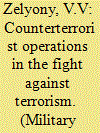

|
|
|
|
|
| Publication |
2014.
|
| Summary/Abstract |
With reference to special measures taken by the Israeli authorities, the author examines the nature and specific aspects of counterterrorist operations, suggest his own definition and develops a classification of the fight against terrorism.
|
|
|
|
|
|
|
|
|
|
|
|
|
|
|
|
| 13 |
ID:
131472
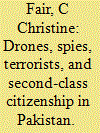

|
|
|
|
|
| Publication |
2014.
|
| Summary/Abstract |
This essay reviews seven recent books and reports that focus upon the use of US armed drones in Pakistan's Federally Administered Tribal Areas (FATA). This essay synthesizes a historical account of the program, critically interrogates key arguments and evidence advanced by the authors, and draws attention the particular problems that confront those who live in the FATA and the second-class citizenship that the Pakistani state has bestowed upon them for reasons of domestic and foreign policy concerns. This review essay does not intend to be the final word on any of the ongoing policy debates. But it does hope to enable a wider audience to take part in these important deliberations.
|
|
|
|
|
|
|
|
|
|
|
|
|
|
|
|
| 14 |
ID:
134042
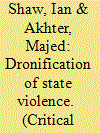

|
|
|
|
|
| Publication |
2014.
|
| Summary/Abstract |
This article explores the shifting methods of U.S. state violence. Building on their earlier work, the authors focus on the use of drones for targeted killings in Pakistan, but here they tease out the wider implications for the future of "warfare"-particularly the meaning and extent of sovereignty and territory. The authors argue that drone strikes both emerge from and feed back into a series of evolutions in the nature of state violence, centered on the intensely bureaucratic and automated delivery of death. This technopolitical transformation, they contend, is underwritten by the abandonment of "thought" and the ascendance of what Hannah Arendt calls an unaccountable "rule by nobody." To build this argument, the authors investigate the institutional conditions of modern-day drone strikes, moving historically and geographically to the birth of the Predator drone and the rise of the CIA in 1980s Afghanistan. By studying nonhuman sources of power, the authors argue that today's planetary manhunt exceeds any direct human control. They conclude by exploring the "individualization" of targeting and its likely consequences for war and law enforcement.
|
|
|
|
|
|
|
|
|
|
|
|
|
|
|
|
| 15 |
ID:
128604
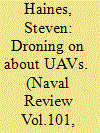

|
|
|
|
|
| Publication |
2013.
|
| Summary/Abstract |
The author, specialist in international law, examines the current debate over UAVs from a practical, moral ethnical and legal viewpoint. He considers and weights the evidence before coming to a conclusion on these matters. In the end he reminds us that these are only some of the things to be considered in the complex political and military equation that is modern warfare.
|
|
|
|
|
|
|
|
|
|
|
|
|
|
|
|
| 16 |
ID:
131057
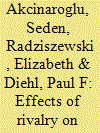

|
|
|
|
|
| Publication |
2014.
|
| Summary/Abstract |
The paper investigates how states manage multiple rivalries when faced with immediate threats. We argue that accommodation of one rival allows states to shift resources from the management of another rival to deal with the costs of immediate threats. By examining enduring rivalries from 1966 to 1999, we show that states' reliance on accommodation in response to threats varies depending on the number of severe threats and the relative capabilities between the states and the threat-issuing rivals. Findings show that when faced with severe but few threats, states prefer to accommodate rivals that did not issue the threat. They are also more likely to give larger concessions to such rivals and to those issuing less severe threats. Finally, the greater the military capability of a rival issuing a severe threat relative to that of the challenged state, the more likely that a threatening rival is accommodated.
|
|
|
|
|
|
|
|
|
|
|
|
|
|
|
|
| 17 |
ID:
132260
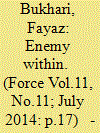

|
|
|
|
|
| Publication |
2014.
|
| Summary/Abstract |
This year the Indian Army achieved a major success by killing 41 militants including 11 top commanders of Lashkar-e-Toiba (LeT), Jaish-e-Mohammad (JeM) and Hizbul Mujahideen (HM) and arrested 23 of them in joint operations with the police.
The figures reveal that this is more than the number of militants neutralised last year, but over the years killing of militants is not making much of a difference as new recruits replace them.
Lieutenant General Subrata Saha, who took over as the General Officer Commanding (GOC) of Army's strategic Chinar Corps or 15 Corps, responsible for tackling militancy in Kashmir besides guarding the Line of Control (LC), has a bigger challenge ahead. For him, killing the militancy is a challenge and not counting the dead.
As per the figures given by the Jammu and Kashmir Police, there are 130 active militants in Kashmir valley and if the rate at which they were eliminated this year continues, not a single militant will be left by next year.
Says a senior army officer: "That is not the case, as per our records at least 16 Kashmiri youth, mostly educated, joined militancy this year. The numbers could be more than our records. And on an average two-three youth get lured into militancy during the funeral of a militant commander."
|
|
|
|
|
|
|
|
|
|
|
|
|
|
|
|
| 18 |
ID:
128229
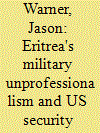

|
|
|
|
|
| Publication |
2013.
|
| Summary/Abstract |
The United States military's Combined Joint Task Force - Horn of Africa (CJTF-HOA) is in need of capable and dependable regional military allies as it seeks to bring stability to the Horn of Africa. Eritrea - once a proclaimed US friend and home to one of Africa's largest military establishments - superficially seems to fit the bill. Drawing from literature on the 'unprofessional nature' of African militaries as well as the scant amount of open source material available on the notoriously secretive nation, this article argues that despite its experienced and well-funded military, President Isaias Afewerki's overbearing control of it has made Eritrea's military highly 'unprofessional' in various ways. As a result, a military that could be a useful US ally in a historically tenuous region will likely remain more of a problem than a boon for the United States into the foreseeable future.
|
|
|
|
|
|
|
|
|
|
|
|
|
|
|
|
| 19 |
ID:
130898
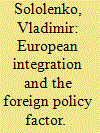

|
|
|
|
|
| Publication |
2014.
|
| Summary/Abstract |
"European integration has progressively moved forward through crisis." "Europe always emerges stronger after a crisis." "Without previous crises, the European Union would not have reached the advanced stage it is at today." Across EU history we have heard such slogans from European heads of state or government, EU officials, and scholars too. They tend to sing the 'Europe moves forward through crisis' refrain almost in tune whenever the next EU challenge comes along. The chorus has swelled to new volumes with the onset of the European sovereign debt crisis.
|
|
|
|
|
|
|
|
|
|
|
|
|
|
|
|
| 20 |
ID:
130899
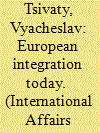

|
|
|
|
|
| Publication |
2014.
|
| Summary/Abstract |
It so happens that we are witnesses to the great geopolitical changes, where one political and economic system is replacing another, where the boundaries of political regions and alliances are shifting, and where the system of international relations is institutionalizing, integrating and transforming. A key characteristic that defines the development vectors of countries in the post- Soviet space is the search by newly independent states for an attractive integration nucleus. On the whole, from all indications, the process of the formation of a more or less stable system of foreign political ties between the post-Soviet states is complete. This accounts for the prevalence of the selective integration vector, namely, the fact that collaboration along the lines of the Customs Union and the EU has taken center stage.
|
|
|
|
|
|
|
|
|
|
|
|
|
|
|
|
|
|
|
|
|